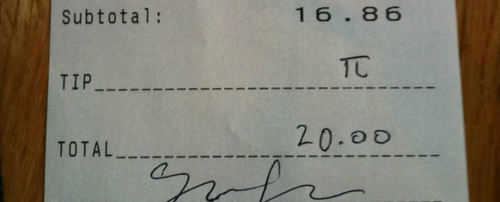A Pi Day Problem
 What is wrong with this image?
What is wrong with this image?
Choices for the answer:
(A) The "TOTAL" value is wrong, it should be greater than the given value.
(B) Nothing is wrong with this picture.
(C) The "TIP" value should be e and not π for the given "TOTAL" value to be correct.
(D) The "TOTAL" value is wrong, it should be less than the given value.
Note: The customer pays via credit card and pays the exact value that is to be paid (in short, do not round up the TOTAL that you get! The customer pays the amount accurately atleast upto 1 0 decimal places).
This section requires Javascript.
You are seeing this because something didn't load right. We suggest you, (a) try
refreshing the page, (b) enabling javascript if it is disabled on your browser and,
finally, (c)
loading the
non-javascript version of this page
. We're sorry about the hassle.
8 solutions
But you can't have fractions of cents so it's rounded correctly. Answer (B) is correct.
Log in to reply
He paid via credit card and was able to pay at accuracy of at least ten decimal places. Therefore A is correct as TOTAL should be more than 20.00
Pretty sure this question tests nothing. It is a fairly debatable answer.
π ≈ 3 . 1 4 1 5 … > 3 . 1 4 ⟹ 1 6 . 3 8 + π > 1 6 . 3 8 + 3 . 1 4 = 2 0 . 0 0 ⟹ TOTAL > 2 0 . 0 0
Log in to reply
Like any waiter would expect to be paid 3 1 4 . 1 5 9 2 6 5 . . . cents.
Log in to reply
The customer paying the tip would be like, "Payment still in progress...." :P
Log in to reply
@Prasun Biswas – I would like to make the point that the total would be £20.00 because the answer comes out as £20.00159... which rounds to £20.00 to the nearest pence and you can't have part of a pence.
Log in to reply
@Curtis Clement – In the world of my fictional problems, you can even have a nanopenny where,
1 penny = 1 0 9 nanopennies
Nonetheless, I have edited the wording of the problem.
Log in to reply
@Prasun Biswas – You can't pay in nanopennies. The value of the total in the problem is correct for currency. The correct answer is B.
Log in to reply
@Rolo Mictlanetcuhtli – That was not in the statement of the problem.
@Rolo Mictlanetcuhtli – Prasun Biswas mentioned in response to Curtis Clement "In the world of my fictional problems, you can even have a nanopenny"
Answer B is correct. Significant figures do in fact matter. Pi=3.141 which rounds to 3.14. The totaling is correct. -_-
The problem is that the total can not have fractions of cents. The note of accurately up to 10 decimal places is absurd because the smallest unit of measure is only two decimal places. The most accurate payment possible is 20.00. If this were simply a math question and not formed into an argument of money then your answer would be correct.
Log in to reply
You do know that there's a separate section called "Quantitative Finance (Beta)" for problems on finance, right?
there in question total is given only 20.00 but not 20.000000. so as per first two decimals it is correct . and total is 20.0015.... as 1 is less than 5 it can be rounded to 0. answer must be B
"in fact, pi has no exact value because it is irrational"
Pi has an exact value...
For TOTAL to be 2 0 . 0 0 , TIP should be 2 0 . 0 0 − 1 6 . 8 6 = 3 . 1 4 .
Since the actual value of π is greater than 3 . 1 4 , TOTAL should actually be greater than 2 0 . 0 0
1 6 . 8 6 + π = 2 0 ⇒ π = 2 0 − 1 6 . 8 6 = 3 . 1 4 ? but π is greater than 3 . 1 4 becasue is 3 . 1 4 1 5 9 2 6 5 3 5 . .
A is wrong
Question not worthy..It can have both the answers A and B, as according to maths we can consider the digits more than 2 decimal places, but in monetary/financially terms we just consider upto 2 decimal places.
Yes, we can sure that 16.84+3.14=20.00, but remember, 22/7>3.14 because Pi is exactly 22/7, the decimal form (3.14) is lower than the actual Pi (22÷7).
Customer was able to pay TOTAL with accuracy of at least ten decimal places. This accuracy is greater than 2 decimal places, so A is answer
Technically, correct answer is A. But in reality, there is nothing wrong with the image since currency is always rounded up to 2 decimal places. So the customer is actually correct since he is paying money. This answer will be accepted in any academic institution.
the total value is short by 0.00159265358979323..............
If 1 6 . 8 6 + π = 2 0 → π = 2 0 − 1 6 . 8 6 = 3 . 1 4 .But 3.14 is only an approximation for π .It is not the exact value;in fact, π has no exact value because it is irrational.It's value to 9 decimal places is 3 . 1 4 1 5 9 2 6 5 3 .Which is greater than 3.14.Therefore when it is added to 16.86.The total will be greater than 20.So answer is A